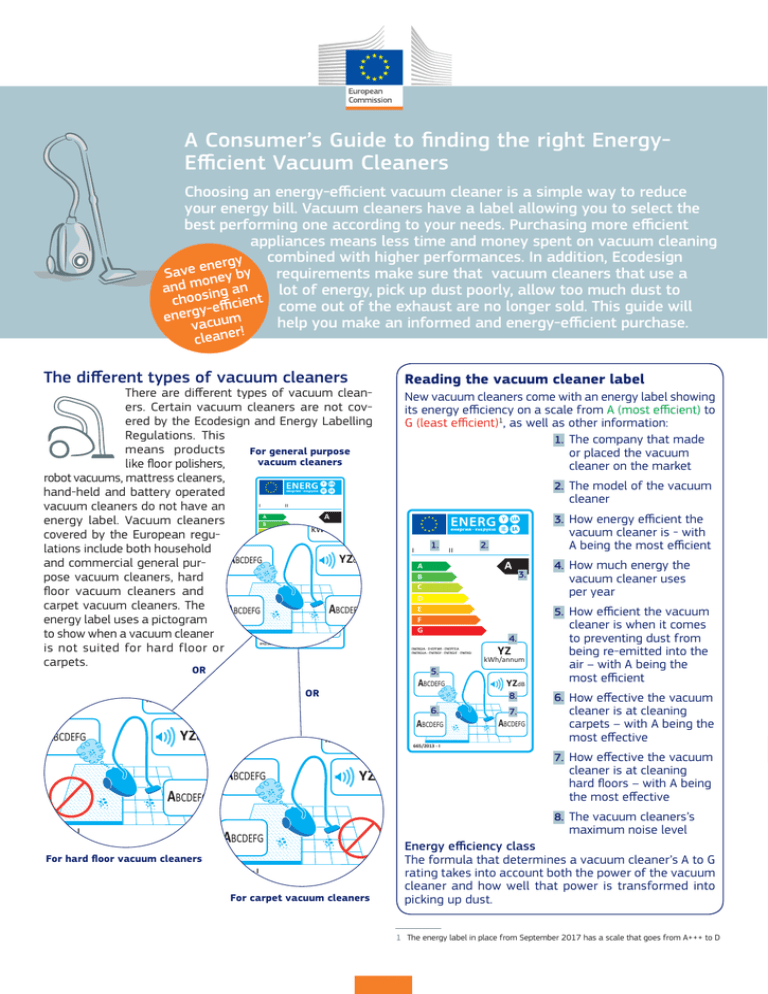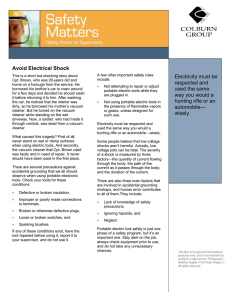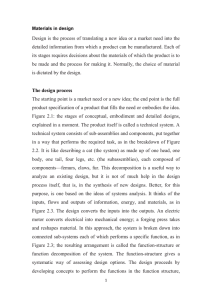Efficient Vacuum Cleaners
advertisement

A Consumer’s Guide to finding the right EnergyEfficient Vacuum Cleaners Choosing an energy-efficient vacuum cleaner is a simple way to reduce your energy bill. Vacuum cleaners have a label allowing you to select the best performing one according to your needs. Purchasing more efficient appliances means less time and money spent on vacuum cleaning combined with higher performances. In addition, Ecodesign nergy e e v a y S requirements make sure that vacuum cleaners that use a oney b and msing an lot of energy, pick up dust poorly, allow too much dust to choo efficient come out of the exhaust are no longer sold. This guide will energycuum help you make an informed and energy-efficient purchase. a v r! cleane The different types of vacuum cleaners I There are different typesIIof vacuum cleaners. Certain vacuum cleaners are notA covA ered by the Ecodesign and Energy Labelling B Regulations. This C means products D For general purpose vacuum cleaners like floor polishers, E robot vacuums, mattress cleaners, F hand-held and battery operated G vacuum cleaners do not have an A A YZ energy label. Vacuum cleaners B kWh/annum C I covered by II the European reguD E lations include both household F A A YZdB A BCDEFG G and commercial general purI II B YZ pose vacuum cleaners, hard kWh/annum C floor vacuum cleaners and YZ ABCDEFG A A carpet vacuum cleaners. The D ABCDEFG ABCDEFG B energy label uses a pictogram E ABCDEFG ABCDEFG C to show when a vacuum cleaner XYZ/2013 -I F is not suited for hard floor orD G carpets. E I Reading the vacuum cleaner label New vacuum cleaners come with an energy label showing its energy efficiency on a scale from A (most efficient) to G (least efficient)1, as well as other information: 1. The company that made or placed the vacuum cleaner on the market 2. The model of the vacuum cleaner II dB 3. How energy efficient the 1. I YZ kWh/annum ABCDEFG F G 4. kWh/annum ABCDEFG YZ kWh/annum 5. YZdB 8. YZ YZdB 3. 4. How much energy the vacuum cleaner uses per year 5. How efficient the vacuum ABCDEFG OR vacuum cleaner is - with A being the most efficient 2. A A B C D E F G XYZ/2013 - I OR II 6. ABCDEFG 665/2013 - I 7. ABCDEFG cleaner is when it comes to preventing dust from being re-emitted into the air – with A being the most efficient 6. How effective the vacuum cleaner is at cleaning carpets – with A being the most effective 7. How effective the vacuum YZdB ABCDEFG cleaner is at cleaning hard floors – with A being the most effective 8. The vacuum cleaners’s XYZ/2013 - I ABCDEFG For hard floor vacuum cleaners XYZ/2013 - I For carpet vacuum cleaners maximum noise level Energy efficiency class The formula that determines a vacuum cleaner’s A to G rating takes into account both the power of the vacuum cleaner and how well that power is transformed into picking up dust. 1 The energy label in place from September 2017 has a scale that goes from A+++ to D Lower wattage – better performance -20 TWh/Year Lower wattage vacuum cleaners can be effective at cleaning our floors and, at the same time, can save as much as 20 TWh of electricity annually in the EU equivalent to the residential electricity consumption of Belgium. Shopping for your vacuum cleaner After you narrow down your options and select the products that meet your needs, comparing to see which product is the most efficient will save you money. You can do this by making sure the product’s energy efficiency label’s colour band is dark green (either as A or A+++ from 2017), and also by checking that it has the lowest annual energy consumption. Going green doesn’t have to be an overwhelming task. Selecting the energy-efficient appliances can provide sig­ nificant benefits for both the environment and your wallet ! For example, you can save up to 70 Euros over the vacuum cleaner’s lifetime with an A model compared to G. Having a vacuum cleaner that is in good working order is essential for energy-efficient cleaning. It will help lower your total energy con­ sumption and maintain high cleaning performance. • Read the label: An A rating means the vacuum cleaner is in the group of most efficient vacuum cleaners, and can therefore reduce running costs. An A rating on the cleaning performance for carpets and hard floors indicates high performance and can reduce cleaning time. •Consider the dust re-emission level: An important, but often overlooked, element of cleaning ability is the capability of the vacuum cleaner to retain what it picks up, especially the fine particulates. Some dust is re-emitted in the exhaust air of the vacuum cleaner. The better the dust re-emission class, the less dust re-emitted. If anyone in your household is sensitive or allergic to dust in the air, a vacuum cleaner scoring A on the re-emission scale is strongly recommended (see 5. of the label). •Consider the noise level: The amount of noise a vacuum cleaner makes while operating is rated in decibels (dB). To give you some idea of what the scale means, a conversation at home is rated at 50 dB and a motorcycle at 100 dB. Many vacuum cleaners are in the range of about 73 to 80 dB, but you may find them as quiet as 62 dB, or even less. Vacuum cleaners with a noise level above 80 dB will disappear in the coming years. Tips for efficient vacuum cleaning •Nozzles - Always pay attention to what the instructions say about the different nozzles that come with vacuum cleaners. Not using nozzles properly could affect the performance of the vacuum cleaner. • Dust bags - Empty the vacuum cleaner’s dust collector or replace the dust bag regularly. If the bag or bin becomes too full, the performance of the vacuum cleaner can suffer, meaning you spend more time cleaning. There are so many different vacuum cleaners on the market that it can be difficult to choose the right one. •Filters - Change or wash your vacuum cleaner’s filter regularly if required so it doesn’t block the airflow and picks up dust more easily and efficiently. Here some suggestions: • Consider your needs, in particular the type of surface you need to clean. • Cleaning your vacuum cleaner can make it run more efficiently. Clean the appliance according to the manufacturer’s instructions, including under the brush roll, inside the casing and wash all the attachments. More information European Commission Product selectors and calculators • Commission Regulation (EU) No 666/2013 of • • • • 8 July 2013 implementing Directive 2009/125/EC with regard to Ecodesign requirements for vacuum cleaners • Commission Delegated Regulation (EU) No 665/2013 of 3 May 2013 supplementing Directive 2010/30/EU with regard to Energy Labelling of vacuum cleaners • DG ENER – Energy Efficiency of Products • DG ENTR – Ecodesign and Energy Labelling Topten.eu Sust-it product selector Sust-it energy use calculator EnergyUseCalculator


